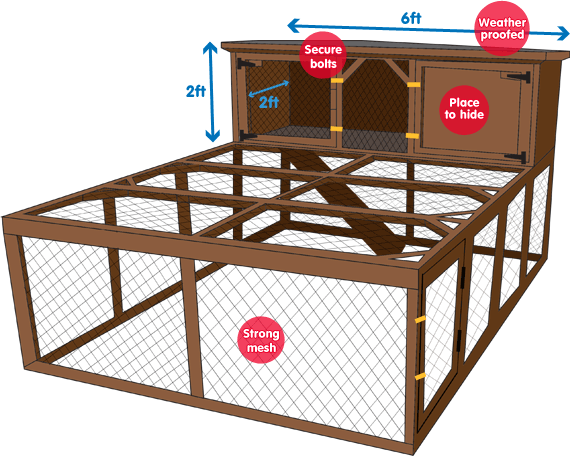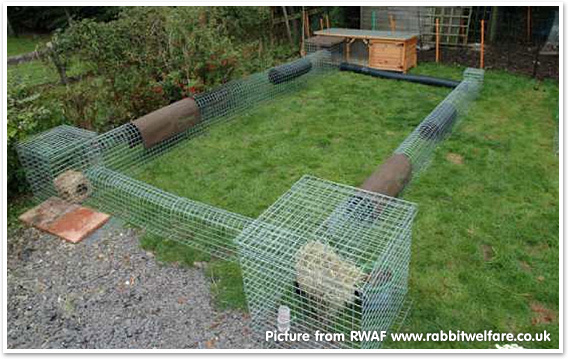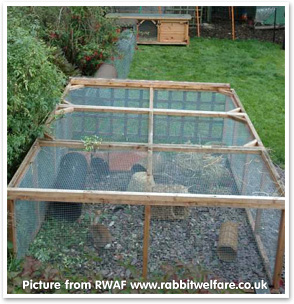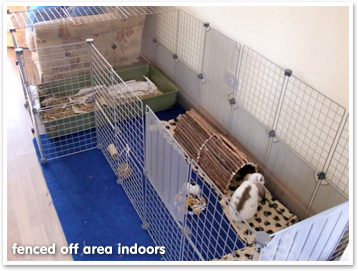Hutches, runs and alternative rabbit housing
Rabbits in the wild cover an area the size of 30 tennis courts every day, running, playing and foraging for food. Domesticated rabbits need this same amount of exercise to keep them fit and healthy, as well as keeping them entertained and their minds active! Typical pet shop hutches and runs are way too small, even those labelled 'large' or 'mansion', so you may have to look elsewhere for something suitable for your bunnies.
How big should a hutch and run be?
6ft x 2ft x 2ft HUTCH + an additional 8ft x 4ft x 4ft RUN (or secure area to exercise in), and the 2 should be joined to allow rabbits to exercise when they want to. These are the minimum measurements according to the Animal Welfare Act.
The rabbit hutch below shows an attached run which is roughly 6ft wide x 8ft long. The ladder leading to the top allows the rabbits to exercise as they please, with a place to hide at the top. On outdoor hutches you must use bolts, not catches, to secure doors. There is a third door at the bottom of the run (also with bolts) to allow your rabbits to go in and out for free time when you are with them. The lids on this type of run also lift up so you can reach your rabbits. See 'security and protection' further down the page for more info on making your rabbits' home secure.

But a 6 x 2 x 2ft hutch looks massive!
We have all grown up with the impression that rabbits are fine to keep in small cages. Luckily this perception is changing. After seeing how much exercise they need, how could they get that much in a small hutch? A bunny lying down spread out is astonishingly long! The minimum sized hutch should equal 4 stretched out rabbits in a row, or 4 rabbit hops from one side to the other. A large 'bedroom' space is essential to lock your bunnies in at night to keep them safe from predators, so a shed with attached run is ideal.
Please watch this short video - it's great for giving ideas on how to setup your bunnies' area
So what should I buy and where from?
Hutches aren't the only option for keeping your rabbits in, and the alternatives can often work out cheaper! For a similar price or less, you could buy a shed or child's playhouse, which has the added bonus of you being able to sit inside and spend more time with your rabbits instead of crouching down to reach into a hutch - which soon gets uncomfortable! If you still prefer a hutch, search online or put an advert in a newspaper for a hutch and state the measurements - 6 x 2 x 2ft. Or contact your local rescue who may be able to give you some good contacts. Failing that you could always make one yourself or ask a carpenter. View our housing gallery for ideas.
If you have not already bought a hutch, wait until you have spoken to the rescue you'll be getting your rabbits from, as they can advise you what would suit your situation best. Hutches with multiple levels may look big but you lose a lot of floor space due to the ladders and holes. A one-level longer hutch is better.
What about something to exercise in?
Outdoor rabbits need an additional run to their main housing. Ideally it should be permanently attached to the hutch so they can decide when they go outside to stretch their legs. It should measure at least 8ft x 4ft x 4ft to give them room to run and jump. They are very active, fast animals with powerful back legs, and they need a lot of exercise to prevent muscle wastage. If you are going to let them exercise loose in the garden you MUST always be outside with them watching them, and your garden must be bunny proofed - to stop them escaping, protect them from predators, and to prevent them from eating any poisonous plants. The photo below shows a circuit which will keep them on the move and stimulated.

 This information is taken from the RWAF's guide: A hutch is not enough.
This information is taken from the RWAF's guide: A hutch is not enough.
"Another view of the 6ft hutch and 8ft run, with the tunnel system linking them. The run is on gravel and is dig proof, but rabbits do need to dig so there is a digging pot in there, and an old hanging basket full of hay acting as a large hayrack, as well as a selection of toys. The tunnels give the rabbits the chance to eat grass, and the whole thing is at the back of the garden so it doesn’t take up room in the middle of the lawn – there is still room for the children or dogs to run about and the fence and shrubs give the rabbits some shelter." You can download their leaflet from their website by clicking here.
Do they have to live outside or can rabbits live indoors?
 You can of course keep rabbit indoors, so you won't need a 'hutch' (though they'll still need a base). It is also easier to keep them safe from predators, weather conditions, and escaping! Speaking from experience, rabbits are a joy to live with and see snuggled up together on a rug in front of the TV!
You can of course keep rabbit indoors, so you won't need a 'hutch' (though they'll still need a base). It is also easier to keep them safe from predators, weather conditions, and escaping! Speaking from experience, rabbits are a joy to live with and see snuggled up together on a rug in front of the TV!
Click here to read more about keeping rabbits as house pets.
Security and protection
If your rabbits are to live outside, their housing should should be in a shaded area out of direct sunlight, sheltering and protecting them from extremes of weather and temperature. It should be free from leaks or gaps which the wind or rain could blow through, and the doors and lids need to have strong bolts on. Many shop-bought hutches have wooden catches on which a fox could easily open by scratching at them so you'll need to replace these. There should be a large sized 'private/ bedroom' area for the rabbits to hide in, as well as lots of fresh hay to act as bedding, keep them warm, to eat, and to bury themselves in if scared. Use a strong mesh, not chicken wire as this is easily chewed through. Choose a good quality wood, nothing thin, as again this could be chewed through.
A hutch, or the hutch part of a hutch/run combo should ideally be raised off the ground to protect the rabbits from cold and wet ground conditions.
When the weather is particularly cold, you should consider moving your rabbits’ home somewhere warmer such as a shed, unused garage or outhouse. See our hot weather and cold weather advice pages for tips on regulating your bunnies' temperatures.
Further info
- Make your rabbits' housing, run, and general environment fun and interactive for them. See our 'bunny playtime' page.
- Visit the RWAF's page: A hutch is not enough
- Download the RWAF leaflet on how to make your rabbit's hutch/run better (PDF)

